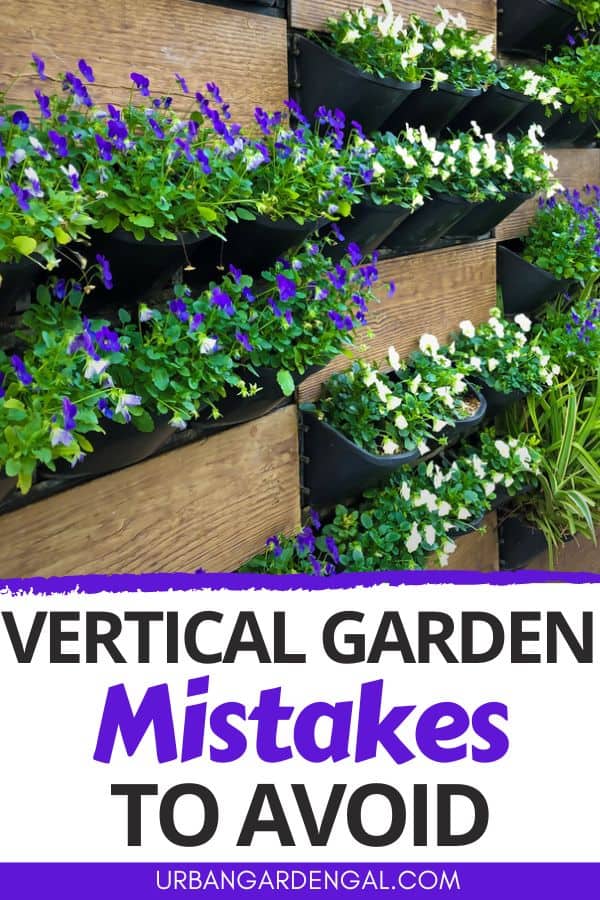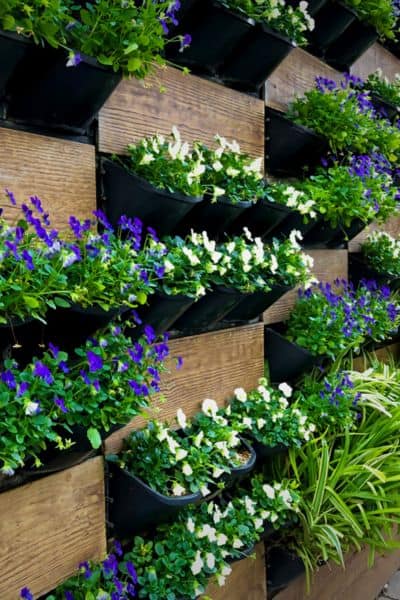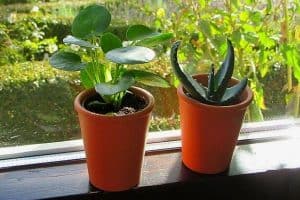Vertical gardens are a great way to maximize your growing space and create a stunning visual display.
However, it’s easy to make mistakes when building and planting out your vertical garden.
In this article I’ll explore 11 common vertical garden mistakes and give you my best tips to properly plan, maintain, and care for your vertical garden.
This post contains affiliate links. Please read the disclosure for more info.
11 VERTICAL GARDEN MISTAKES
1. Inadequate Sunlight
As a landscape gardener, one of the most common vertical garden mistakes I see is not considering the amount of sunlight the plants will receive.
Most plants require at least 6 hours of sunlight per day to grow properly, so choosing a spot with inadequate sunlight can result in weak, leggy and unhealthy plants.
Before installing your vertical garden, observe the area throughout the day to determine how many hours of sunlight it receives.
Make sure to choose plants that are suitable for the light conditions available at your chosen site.
2. Ignoring the Climate
Neglecting to consider the climate you live in and how it affects your plants is another common mistake.
Each plant has specific needs for temperature, light, and moisture. Keep these factors in mind:
Temperature: Some plants are sensitive to extreme temperatures, so it is crucial to choose the appropriate plants for your area’s climate. If you live in a cool climate area you’ll need to choose frost tolerant plants.
Moisture: If you live in a region with heavy rainfall, consider selecting plants that can withstand excessive moisture. On the other hand, if you live in an area with low rainfall, choose plants that are drought tolerant.
Wind: If your vertical garden is situated on a rooftop or balcony, make sure your vertical garden is sheltered from strong winds.
Install wind-blocking panels or install a shade cloth to provide protection from extreme weather.
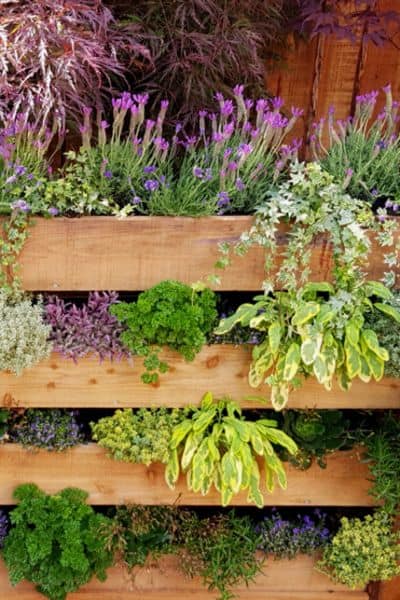
3. Poor Ventilation
Proper air circulation is essential for the health of your plants as it helps reduce the risk of fungal and bacterial diseases.
When choosing a site for your vertical garden, make sure there is adequate space between plants and walls to allow for air circulation.
4. Choosing Incompatible Plants
When starting a vertical garden, it’s important to select plants that thrive together in the same environment.
Choose plants with complementary growth habits, such as those with trailing or climbing habits, to maximize the use of your vertical space.
5. Poor Quality Potting Mix
A poor quality potting mix can affect plant growth and health.
I always use a well-draining, nutrient-rich mix to support the plants and it’s a good idea to consider using a mix suitable to the specific needs of your plants.
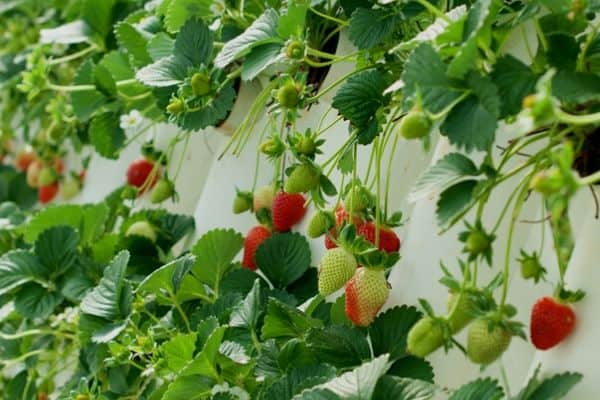
6. Watering Incorrectly
Both overwatering and underwatering can be harmful to plants.
One way to ensure that the plants get enough water is to install a drip irrigation system that delivers water directly to the roots of each plant.
Another option is to water the plants manually using a watering can or hose, but it’s important to water slowly and evenly to allow the water to penetrate the soil.
Start by watering the plants at the top of the vertical garden, so that the runoff can trickle down to plants in the lower levels.
It’s a good idea to check the moisture level of the soil regularly and adjust the watering schedule as needed to prevent over or under-watering.
7. Overcrowding Plants
Overcrowding plants in a vertical garden can affect their growth and health.
When plants are too close together, they compete for resources such as water, nutrients, and sunlight, which can stunt their growth and make them more susceptible to diseases and pests.
Additionally, overcrowded plants can create a humid environment that promotes the growth of mold and mildew.
To avoid overcrowding, it’s important to choose plants that are appropriate for the size of the garden and leave enough space between them to allow for proper air circulation and growth.
Regular pruning and maintenance can also help to keep the plants healthy and prevent overcrowding.

8. Neglecting to Train the Plants Upwards
Training plants to grow upwards is essential in vertical gardening. Use supports like stakes, trellises, or wireframes to encourage this growth pattern.
Training plants upwards helps to maximize the use of space in the garden, allowing for more plants to be grown in a smaller area and it can improve air circulation and sunlight exposure for the plants, which can lead to healthier growth and better yields.
9. Lack of Fertilizer
Vertical gardens tend to have limited soil volume and nutrients, so it’s important to supplement the soil with fertilizer to ensure that the plants have the nutrients they need to thrive.
Fertilizer provides essential macronutrients such as nitrogen, phosphorus, and potassium, as well as micronutrients such as iron, zinc, and magnesium.
These nutrients help to support the plants’ growth, improve their resistance to pests and diseases, and increase their yields.
Fertilizing should be done regularly throughout the growing season, for the best results.
I like to use a weak solution of liquid fertilizer each week, but if you don’t have time for that, you can use a slow-release fertilizer, which will release the nutrients over a few months.
According to the University of Maryland Extension, plants should be watered well after adding fertilizer to make the nutrients soluble and available to plants and to prevent salt burn of the roots.
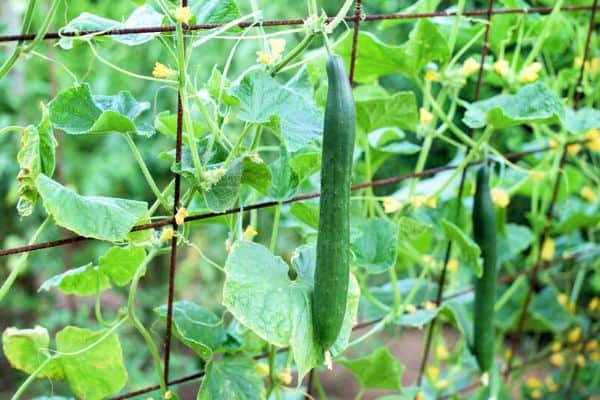
10. Overlooking Maintenance Needs
Regular maintenance is essential for a successful vertical garden.
Pruning helps to keep the plants healthy and encourages new growth, while regular weeding helps to prevent competition for resources.
Regular maintenance also includes monitoring the garden for pests and diseases and taking appropriate action to prevent or treat them.
11. Infrequent Harvesting
Frequent harvesting is important when growing vegetables in a vertical garden to promote the growth and health of the plants.
When fruits and vegetables are left to grow too long without being harvested, they can become overripe or start to decay, which can attract pests and diseases.
Regular harvesting also helps to encourage the plants to produce more fruits, vegetables, or flowers, and extends the harvest season.
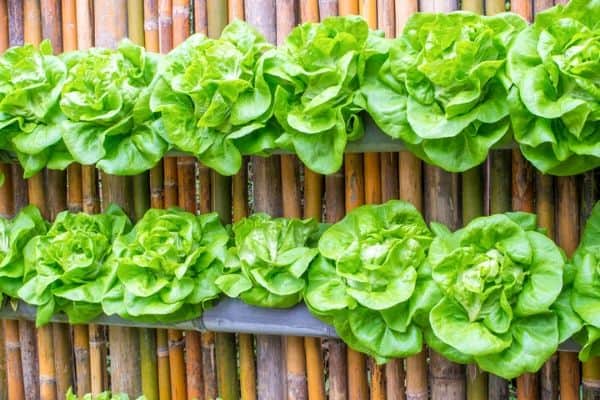
By avoiding these common mistakes, your vertical garden will not only be visually appealing but also achieve optimal plant growth and health.
With careful plant selection and attentive care, you can create a thriving vertical garden that produces an abundance of fruit, vegetables, or flowers.
RELATED ARTICLES
- Vertical Garden Lighting Guide
- 8 Vertical Fence Garden Ideas
- How To Grow Strawberries Vertically
- How To Create A Vertical Plant Wall
- 7 Benefits of Trellising Plants
Have you had success with vertical gardening? Let me know in the comments below.
Are you on Pinterest? I have boards dedicated to Climbing Plants and Urban Gardening that you may enjoy. You can also find me on Facebook.
